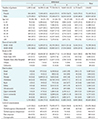2. Park J, Lim T. Korean Triage and Acuity Scale (KTAS). J Korean Soc Emerg Med. 2017; 28(6):547–551.
3. Ryu JH, Min MK, Lee DS, Yeom SR, Lee SH, Wang IJ, et al. Changes in relative importance of the 5-level triage system, Korean Triage and Acuity Scale, for the disposition of emergency patients induced by forced reduction in its level number: a multi-center registry-based retrospective cohort study. J Korean Med Sci. 2019; 34(14):e114.

4. Kwon H, Kim YJ, Jo YH, Lee JH, Lee JH, Kim J, et al. The Korean Triage and Acuity Scale: associations with admission, disposition, mortality and length of stay in the emergency department. Int J Qual Health Care. 2019; 31(6):449–455.

5. Hinson JS, Martinez DA, Cabral S, George K, Whalen M, Hansoti B, et al. Triage performance in emergency medicine: a systematic review. Ann Emerg Med. 2019; 74(1):140–152.

7. Nemati S, Holder A, Razmi F, Stanley MD, Clifford GD, Buchman TG. An interpretable machine learning model for accurate prediction of sepsis in the ICU. Crit Care Med. 2018; 46(4):547–553.

8. Gupta A, Liu T, Shepherd S, Paiva W. Using statistical and machine learning methods to evaluate the prognostic accuracy of SIRS and qSOFA. Healthc Inform Res. 2018; 24(2):139–147.

9. Park JH, Shin SD, Song KJ, Hong KJ, Ro YS, Choi JW, et al. Prediction of good neurological recovery after out-of-hospital cardiac arrest: a machine learning analysis. Resuscitation. 2019; 142:127–135.

10. Stewart J, Sprivulis P, Dwivedi G. Artificial intelligence and machine learning in emergency medicine. Emerg Med Australas. 2018; 30(6):870–874.

11. Hong WS, Haimovich AD, Taylor RA. Predicting hospital admission at emergency department triage using machine learning. PLoS One. 2018; 13(7):e0201016.

12. Goto T, Camargo CA Jr, Faridi MK, Freishtat RJ, Hasegawa K. Machine learning-based prediction of clinical outcomes for children during emergency department triage. JAMA Netw Open. 2019; 2(1):e186937.

13. Kwon JM, Lee Y, Lee Y, Lee S, Park H, Park J. Validation of deep-learning-based triage and acuity score using a large national dataset. PLoS One. 2018; 13(10):e0205836.

14. Raita Y, Goto T, Faridi MK, Brown DFM, Camargo CA Jr, Hasegawa K. Emergency department triage prediction of clinical outcomes using machine learning models. Crit Care. 2019; 23(1):64.

15. Levin S, Toerper M, Hamrock E, Hinson JS, Barnes S, Gardner H, et al. Machine-learning-based electronic triage more accurately differentiates patients with respect to clinical outcomes compared with the emergency severity index. Ann Emerg Med. 2018; 71(5):565–574.e2.
16. Sterling NW, Patzer RE, Di M, Schrager JD. Prediction of emergency department patient disposition based on natural language processing of triage notes. Int J Med Inform. 2019; 129:184–188.

17. McKinney W. Data structures for statistical computing in python. In : Proceedings of the 9th Python in Science Conference; 2010 Jun 28-Jul 3; Austin, TX. p. 51–56.
18. Pedregosa F, Varoquaux G, Gramfort A, Michel V, Thirion B, Grisel O, et al. Scikit-learn: machine learning in Python. J Mach Learn Res. 2011; 12:2825–2830.
20. Breiman L. Random forests. Mach Learn. 2001; 45(1):5–32.
21. Fernandez-Delgado M, Cernadas E, Barro S, Amorim D. Do we need hundreds of classifiers to solve real world classification problems? J Mach Learn Res. 2014; 15(1):3133–3181.
22. Chen T, Guestrin C. XGBoost: a scalable tree boosting system. In : Proceedings of the 22nd ACM SIGKDD International Conference on Knowledge Discovery and Data Mining; 2016 Aug 13-17; San Francisco, CA. 785: 794.
23. Nielsen D. Tree boosting with XGBoost: why does XGBoost win “every” machine learning competition? [master's thesis]. Trondheim, Norway: Norwegian University of Science and Technology;2016.
24. Passalis N, Tefas A. Entropy optimized feature-based bag-of-words representation for information retrieval. IEEE Trans Knowl Data Eng. 2016; 28(7):1664–1677.

25. Sidorov G, Velasquez F, Stamatatos E, Gelbukh A, Chanona-Hernandez L. Syntactic n-grams as machine learning features for natural language processing. Expert Syst Appl. 2014; 41(3):853–860.

26. Park JB, Lee J, Kim YJ, Lee JH, Lim TH. Reliability of Korean Triage and Acuity Scale: interrater agreement between two experienced nurses by real-time triage and analysis of influencing factors to disagreement of triage levels. J Korean Med Sci. 2019; 34(28):e189.

27. Moon SH, Shim JL, Park KS, Park CS. Triage accuracy and causes of mistriage using the Korean Triage and Acuity Scale. PLoS One. 2019; 14(9):e0216972.

28. Levis T, Schwartz D, Bitan Y. Triage nurses decision-support application design. Proc Int Symp Hum Factors Ergon Healthc. 2018; 7(1):52–55.

29. Dehghani Soufi M, Samad-Soltani T, Shams Vahdati S, Rezaei-Hachesu P. Decision support system for triage management: a hybrid approach using rule-based reasoning and fuzzy logic. Int J Med Inform. 2018; 114:35–44.






 PDF
PDF ePub
ePub Citation
Citation Print
Print





 XML Download
XML Download